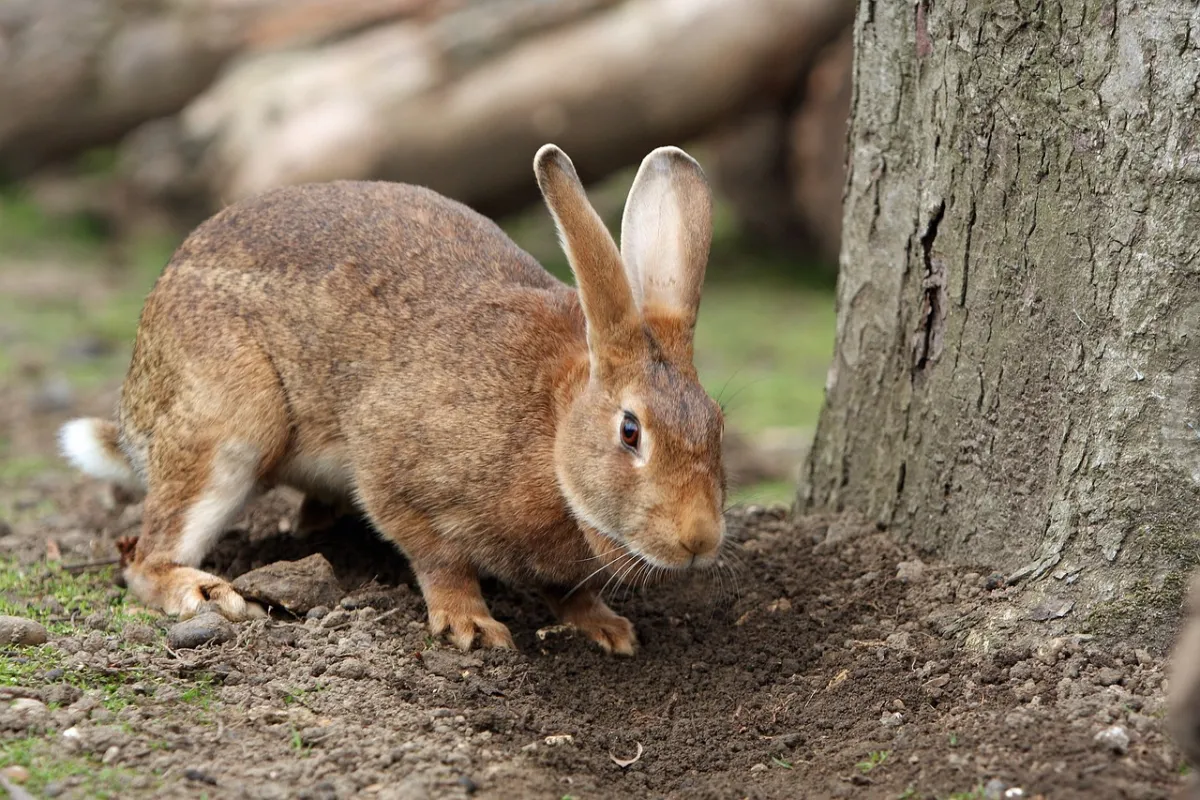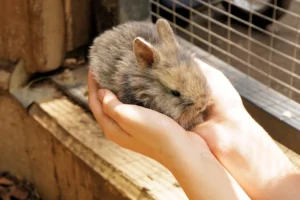Are you curious why rabbits dig those shallow holes in your yard? Well, wonder no more! In this article, we will delve into the fascinating world of rabbit behavior and uncover the ecological significance behind their digging habits.
From creating safe hideaways to regulating their body temperature, these shallow holes serve a crucial purpose in the lives of these furry creatures.
So, grab your shovel and let’s dig into the secrets of rabbit holes together!
In This Article
- 1 Key Takeaways
- 2 Ecological Significance of Shallow Hole Digging
- 3 Natural Instincts: Understanding Rabbit Behavior
- 4 Creating Safe Hideaways: Rabbits’ Purpose for Digging
- 5 Temperature Regulation: How Shallow Holes Help Rabbits
- 6 Nesting and Reproduction: The Role of Shallow Holes
- 7 Rabbit Territories and Marking Behavior: Exploring Shallow Holes’ Function
- 8 Frequently Asked Questions
- 8.1 How Do Rabbits Choose the Location for Digging Shallow Holes?
- 8.2 Can Rabbits Dig Multiple Shallow Holes in One Area?
- 8.3 Do Rabbits Ever Reuse Shallow Holes?
- 8.4 Are There Any Risks or Dangers Associated With Rabbits Digging Shallow Holes?
- 8.5 Can Humans Discourage Rabbits From Digging Shallow Holes in Their Yards?
- 9 Conclusion
Key Takeaways
- Digging shallow holes allows rabbits to aerate the soil, improving overall soil health and promoting plant growth.
- Shallow holes serve as safe hideaways and protection for rabbits, allowing them to evade predators and fulfill their natural instincts.
- Rabbits dig shallow holes for temperature regulation, using them as cooling mechanisms in hot weather and as insulation in colder weather.
- Shallow holes are crucial for nesting and reproduction, providing a safe environment for raising young and protecting them from predators.
Ecological Significance of Shallow Hole Digging
You should consider the ecological significance of shallow hole digging by rabbits.
Rabbits are known for their burrowing patterns, which play a vital role in the environment. By digging shallow holes, rabbits help with soil aeration. As they create these holes, they loosen the soil, allowing air, water, and nutrients to penetrate deeper into the ground. This process improves the overall health of the soil, benefiting both plants and other organisms.
Additionally, the burrowing patterns of rabbits create habitats for various small animals and insects, promoting biodiversity. These burrows also serve as shelters from predators and harsh weather conditions.
Understanding the ecological significance of shallow hole digging by rabbits can help us appreciate the important role they play in maintaining a balanced ecosystem.
Natural Instincts: Understanding Rabbit Behavior
Understanding a rabbit’s natural instincts can help you develop a deeper understanding of their behavior. Rabbits are fascinating creatures, with unique behaviors and communication methods. Digging is a fundamental aspect of a rabbit’s natural instincts, serving several purposes in their daily lives. Here are some key points to consider:
- Social interaction: Digging plays a crucial role in rabbit communication. By creating shallow holes, rabbits leave scent marks that act as signals to other rabbits. These scent marks convey information about territory boundaries and reproductive readiness.
- Foraging behavior: Rabbits are herbivores and rely on finding food in their environment. Digging allows them to uncover hidden sources of food, such as roots, tubers, and other plant material. It’s an essential skill for survival and helps them meet their dietary needs.
- Nesting and shelter: Rabbits also dig shallow holes to create nests or burrows for shelter and protection. These holes provide a safe space for them to rest, reproduce, and raise their young.
- Thermoregulation: Digging can also help rabbits regulate their body temperature. By digging shallow holes in the ground, they can access cooler soil during hot weather or warmer soil during colder periods.
Understanding these natural instincts and behaviors can help us better care for rabbits, ensuring their physical and emotional well-being. By providing opportunities for digging, such as sandboxes or designated areas in their enclosures, we can promote their natural behaviors and enhance their overall quality of life.
Creating Safe Hideaways: Rabbits’ Purpose for Digging
Sometimes, rabbits dig shallow holes to create safe hideaways. They use these hideaways for various purposes such as nesting, shelter, and thermoregulation. Shelter construction is a crucial instinctual behavior that helps rabbits evade predators and ensure their survival. By digging shallow holes, rabbits create a secure space where they can seek refuge from approaching danger. These hideaways provide a sense of safety and protection, allowing rabbits to rest, sleep, and even give birth to their young.
Additionally, these shallow holes aid in thermoregulation. They provide a cooler environment during hot weather and a warmer environment during colder temperatures. Understanding the purpose behind rabbits’ digging behavior allows us to better serve these animals. By providing them with suitable environments where they can fulfill their natural instincts and thrive.
Temperature Regulation: How Shallow Holes Help Rabbits
Digging shallow holes helps rabbits regulate their body temperature by providing them with a cooler space during hot weather and a warmer space during colder temperatures. This heat management technique is an essential aspect of their survival.
Here’s how rabbits use shallow holes to regulate their body temperature:
- Cooling mechanism: Rabbits dig shallow holes to escape the heat and cool down their bodies. By burrowing into the ground, they can find relief from the scorching temperatures.
- Ground insulation: The soil acts as an insulator, helping rabbits stay warm during colder weather. The shallow holes provide a protected space where they can huddle and conserve heat.
- Natural cooling system: The evaporation of moisture from the soil cools the air around the rabbit’s body. This helps them maintain a comfortable body temperature even in hot conditions.
- Adaptation to surroundings: Rabbits instinctively know how to create these shallow holes to adapt to their environment and regulate their body temperature effectively.
Nesting and Reproduction: The Role of Shallow Holes
Using shallow holes for nesting and reproduction is a crucial strategy for rabbits to ensure the survival of their offspring. Rabbits, being small and vulnerable prey animals, rely on burrow construction to protect their young from predators.
These shallow holes, known as forms, are carefully constructed by the female rabbit, or doe, using her strong hind legs. The doe digs a shallow depression in the ground and lines it with grass, fur, and other soft materials to create a cozy nest. This nest provides a safe and secure environment for the newborn kits, shielding them from predators and harsh weather conditions.
The shallow holes also serve as a hiding place for the doe, allowing her to keep a watchful eye on her young while avoiding detection by potential threats.
Overall, the use of shallow holes for nesting and reproduction plays a vital role in the survival and success of rabbit populations.
Rabbit Territories and Marking Behavior: Exploring Shallow Holes’ Function
Have you ever wondered about the function of shallow holes in rabbit territories and their marking behavior? Understanding natural instincts and exploring marking behavior is crucial to serving the needs of rabbits in their habitats. Let’s delve into this fascinating topic!
- Shallow holes serve as scent traps, allowing rabbits to mark their territory with their unique scent.
- These holes also provide rabbits with a safe spot to hide from predators, as they can quickly retreat into them.
- Rabbits use these holes as a means of communication, leaving messages for other rabbits in the area.
- The digging behavior helps maintain the health of rabbit’s teeth, which continuously grow.
Frequently Asked Questions
How Do Rabbits Choose the Location for Digging Shallow Holes?
When digging shallow holes, rabbits choose locations based on instinct and territoriality. Their burrowing behavior affects the environment by aerating the soil and creating hiding spots. By following their natural instincts, rabbits ensure their safety and survival.
Can Rabbits Dig Multiple Shallow Holes in One Area?
Rabbits can indeed dig multiple shallow holes in one area. This behavior is a natural part of their burrowing behavior in the wild. However, it can have a negative impact on gardens and crops.
Do Rabbits Ever Reuse Shallow Holes?
Rabbits sometimes reuse shallow holes for nest building. This behavior is beneficial for their survival as it provides protection and insulation for their young. It also conserves energy and resources.
Are There Any Risks or Dangers Associated With Rabbits Digging Shallow Holes?
When rabbits dig shallow holes, there can be risks and dangers involved. These holes can pose a threat to gardens, as they may damage plants and create tripping hazards. It’s important to take precautions to protect your garden from the impact of rabbit holes.
Can Humans Discourage Rabbits From Digging Shallow Holes in Their Yards?
To prevent rabbits from digging shallow holes in your yard, try these simple preventive methods. Provide alternative digging spots, such as a designated area with loose soil or a sandbox. This will help redirect their natural digging instincts.
Conclusion
In conclusion, the shallow hole digging behavior of rabbits serves multiple purposes in their natural habitat.
From creating safe hideaways to regulating their body temperature, these furry creatures demonstrate their instinctual need for these burrows.
Moreover, shallow holes play a crucial role in nesting and reproduction, as well as marking their territories.
Understanding the ecological significance of this behavior sheds light on the intricate lives of rabbits and their ability to adapt and thrive in various environments.
So next time you see a rabbit digging a shallow hole, appreciate the complexity behind their seemingly simple actions.





